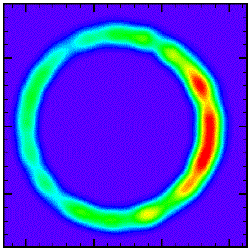|
|
|
|
 R. Grobe & Q. Su/Illinois State Univ.
R. Grobe & Q. Su/Illinois State Univ. |
| Ring around the proton.
According to computer simulations, atomic electrons can be accelerated
close to the speed of light without top-of-the-line lasers if a
magnetic field is applied along with a medium-energy laser. With this
scheme, the simulations predict that a hydrogen atom's electron cloud
can form a large ring. |
|
|
|
|
Blast an atom with a souped-up, high-intensity laser, and you're
sure to see some bizarre effects. Laser physicists call the effects
relativistic when the classical speed of an atomic electron responding
to the strong laser field is near the speed of light. But in the 10 April PRL a team suggests a cheaper approach. According to their computer simulations, the common CO2
laser in combination with a strong magnet can produce the same
relativistic conditions as high-end lasers. Their simulations also
suggest that new effects should be observable with this scheme,
including a ring-shaped electron cloud and a sawtooth-shaped resonance
curve.
Thanks to recent developments in high-intensity, short-pulse laser
technology, experimenters have been observing atoms reacting to extreme
conditions in ways theorists hadn't predicted. For example, an
ultrashort infrared laser pulse can strip an electron from an atom and
slam it back so violently that it emits a laser-like beam of x-ray
photons (high harmonics) 200 times as energetic as the infrared
photons--the shortest wavelength coherent radiation yet produced.
Investigating strong laser-atom interactions is "a fishing expedition"
for many unexplored phenomena, says Rainer Grobe of Illinois State
University (ISU) in Normal, but experiments are always limited by
ionization--atoms fall apart when pushed too hard.
The problem is that the nucleus can't easily hold onto an energetic
electron, but Grobe and his colleagues realized that a strong magnetic
field can help. The field keeps an electron from flying away no matter
how far it strays from the nucleus because the field enforces a curved
path for the electron. With the field tuned so that an electron's
orbital period (cyclotron frequency) matches that of the laser's
oscillating field, the team's computer simulations showed that
electrons could absorb huge amounts of energy within an atom with
easily accessible laser intensities: A 1014 W/cm2 laser along with a 10 T magnetic field pushed electrons close to the speed of light.
Using purely classical (and relativistic) mechanics--a
quantum-mechanics-free approach that others have shown agrees with
experiments--the ISU team simulated a hydrogen atom containing an
electron cloud made of many point-particles and found some surprises.
As the magnetic field is brought close to resonance with the laser, the
electron's speed increases, but the speed-vs-field curve has a
saw-toothed shape, unlike the symmetrical resonance curve expected in
the absence of relativity. There is even a region of the curve where
the electron moves faster with relativity than it would under Newtonian
mechanics--a contrast to most cases, where relativistic effects "slow
down" an accelerating mass.
Another new and purely relativistic effect Grobe and his colleagues
observed was a ring-shaped electron cloud that spins around the nucleus
like a hula hoop around a gyrating child. The ring of charge forms near
resonance and can be 500 nm across, 5000 times larger
than the atom's normal size. The laser-with-magnet scheme also appears
to generate high harmonics, which are normally seen only with much more
powerful lasers.
"It's a brilliant piece of work," says Misha Ivanov of Canada's
National Research Council in Ottawa. He is impressed that the team
managed to discover and describe "very elegant physical effects"--ones
that have been overlooked by others--without getting bogged down in
complex calculations. Best of all, he says, "you don't need a super,
super laser" to observe them.
Videos
Ring-Shaped Electron Cloud Video
This
video shows the development of the ring shape for a hydrogen atom
electron cloud under the influence of a laser and a magnetic field.
GIF (420 KB) MOV (284 KB)
Video courtesy of R. Grobe and Q. Su, Illinois State University.
Information
on viewing video files.
Related information:
Grobe/Su lab
Relativistic Resonances in Combined Magnetic and Laser Fields
R. E. Wagner, Q. Su, and R. Grobe
Phys. Rev. Lett. 84, 3282
(issue of 10 April 2000)
|
|
|